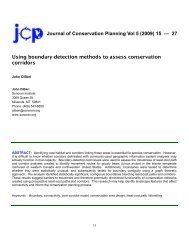Estimating visitor use of protected areas by modeling accessibility: A ...
Estimating visitor use of protected areas by modeling accessibility: A ...
Estimating visitor use of protected areas by modeling accessibility: A ...
You also want an ePaper? Increase the reach of your titles
YUMPU automatically turns print PDFs into web optimized ePapers that Google loves.
THEOBALD, NORMAN, NEWMAN / Journal <strong>of</strong> Conservation Planning Vol 6 (2010) 1—20managers. We maintained consistency with theirestimates based on 10 classes from the USGS NationalLand Cover Dataset when assigning permeability valuesto the 25 vegetation classes. We assumed that hikerswho plan to travel <strong>of</strong>f-trail <strong>use</strong> an existing trail to accessthe closest point to their <strong>of</strong>f-trail destination. Areas wherevegetation is denser (e.g., shrublands) were assigned alower permeability value to reflect the difficult <strong>of</strong>movement. Lakes, large rivers, and wetlands were givena very low permeability value assuming travel throughthese <strong>areas</strong> is difficult.To make the results <strong>of</strong> the <strong>accessibility</strong> <strong>of</strong> the park more<strong>use</strong>ful for park managers, we computed summarystatistics for a variety <strong>of</strong> spatial management zones thatwere defined in parks management plan (NPS 2001): forthe entire park, for the park divided into the east versuswest side <strong>of</strong> the continental divide (that is <strong>of</strong>ten <strong>use</strong>d asfunctional administrative units), for research natural <strong>areas</strong>that serve as reference sites <strong>of</strong> “pristine” ecologicalcondition versus “front-country”, and <strong>by</strong> major ecologicalsystem or life zone (alpine, upper montane, lowermontane, riparian, and savannah). For each zone, wecomputed both average and standard deviation <strong>of</strong> traveltime <strong>by</strong> finding the raster cells that intersected a givenmanagement zone.To meet our second objective, we wanted to understandhow the degree <strong>of</strong> threat to resources has changed fromprevious “natural” conditions to the current state <strong>of</strong>transportation infrastructure. Consequently, we developed<strong>accessibility</strong> surfaces to reflect three scenarios that weredeveloped to inform a Natural Resource ConditionAssessment that we conducted for RMNP:⇒ Scenario A. Current roads & trails: This scenariois based on the current transportationinfrastructure (i.e. roads and trails), and travel timeis the weighted average from the four parkentrances.⇒ Scenario B. Current roads without trails: Thisscenario reflects the road transportationinfrastructure, but does not include the trailsystem. This allowed us to examine how thecurrent trail infrastructure modifies the “natural”<strong>accessibility</strong> to ecological systems in the park.⇒ Scenario C. “Natural” conditions without roads ortrails: This scenario reflects an absence <strong>of</strong>transportation infrastructure (i.e. roads or trails) inthe interior <strong>of</strong> the park. This allowed us toexamine how the “natural” <strong>accessibility</strong> toecological systems varies within in the park.To meet our third objective, we examined the relationshipbetween the presence <strong>of</strong> invasive species and<strong>accessibility</strong>. Managers were particularly concernedabout pathways for exotic species, and in particular therelationship between <strong>visitor</strong> <strong>use</strong> and distribution (andfuture spread) <strong>of</strong> exotic species. We highlight the pattern<strong>of</strong> “cheat grass” (Bromus tectorum) beca<strong>use</strong> it is the mostextensive exotic species in the park and can increasewildfire severity and out-compete native grasses.To compare our measures <strong>of</strong> <strong>accessibility</strong> to existingdensity and distance based approaches, we computedthe average travel time, road/trail density and distancefrom road within park management zones. We alsoexamined the spatial distribution <strong>of</strong> the different methods<strong>by</strong> normalizing the raw travel time (minutes) and density(km/km 2 ) into ranked values (0.0 to 1.0) and overlayedthe normalized values and computed their ratio.RESULTSWe ran the <strong>accessibility</strong> model to calculate average traveltime within the entire park, as well as for <strong>areas</strong> eastversus west <strong>of</strong> the continental divide. The resulting mapsare shown in Figure 2, page 9. For the current road andtrail infrastructure (Scenario A), the average one-waytravel time for RMNP is 3.5 hours (Table 4, page 12).This means that the average travel time from allentrances to all locations in the park is, on average, 3.5hours with a standard deviation <strong>of</strong> 2.3 hours. Roughly 7%<strong>of</strong> the park is within 1 hour, 50% is within 4 hours, and80% <strong>of</strong> the park is within 8 hours. The west side <strong>of</strong> the7



